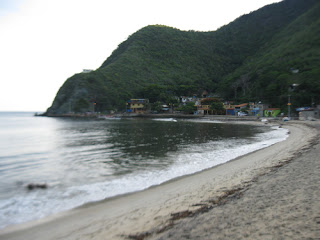domingo, 8 de enero de 2012
Venezuela: The Cacao Route one way to heaven
It is 57 miles between the mountain pass (cloud forest) and stretches of coastline. This is the most important Venezuelan path from the historical, geographical, botanical, or zoological, point of view that is, for the seasoned or novice explorer and trekker, a privilege to know. It is the road that joins two unique towns: Turmero and Chuao, to travel between the two towns, we must overcome the mountain range of central Venezuela called Henrry Pittier Park, that covers an area of 107,800 hectares, and is located in the north of Aragua state, that includes most of the Aragüeñas and the Carabobo mountain ranges.
This route has long been, the road used by the great cocoa growing people of Chuao (on the coast of Aragua) to exit the valley where the principal city of the region is located, Maracay. Today along this pass, some of the routes have to be rediscovered as the forest seems to be trying to mislead and hide them.
The explorers must face an irregular topography, comprised of steep slopes and narrow valleys that cross the north corner. This rugged terrain belongs to the mountain range of Cordillera de la Costa, formed by Mesozoic metamorphic rocks, dating from the Cretaceous period, roughly 70 million years old. Here there are also found basic and acidic rocks: These small valleys are landscapes of the recent Quaternary period. These mountain landscapes are very dynamic and landslides occur frequently in the areas that have steep slopes, and under the conditions of persistent rainfall.
For bird watchers, they have found one of the great shrines of the world. This is home to 520 species of birds, representing approximately 41.6% of the national birdlife and 6.5% of the world's bird species. It is also the travel route of many migratory species, both birds and flying insects. Likewise, it is home to at least 22 endemic or restricted species, some threatened with extinction, such as the helmeted curassow (Pauxi pauxi), the endemic aquaticmouse (Ichtyomys pittieri), marsupial water opossum (Chironectes minimus), jaguar (Panthera onca), puma (Puma concolor), ocelot (Felis sparrows), howling monkey (Alouatta seniculus), tapir (Tapirus land), Kinkajou (Potus flavus) and tayra(Eira barbara).
To scholars of flora, it is the opportunity to observe the coastal grasslands and shrublands, forests and semi deciduous seasonal coastal cloud forests. On the slopes, dry forest, dry deciduous scrub forest, savanna and forest vegetation of high humidity transitional evergreens with marine influence. In the high mountain cloud forest and cloud forest above. Relative humidity is very high, above 1,000 meters. Its most illustrious residents welcome us: the dwarf (Curatella American virgiloides Boudichia), the majaguas (Heliocarpus sp.) And palo maria (Triplaris sp.) Forests of lower altitudes. The bucket or child (Gyranthera caribensis) of the cloud forest as macanilla palms (Bactris setulosa), cane mill (Chamedorea pinnatifrons) PrApa (Wettinia praemorsa) and other Geonoma gender, and Socratea Hyospathe. Aroids, orchids, bromeliads and Piperaceae include in the group of epiphytic plants. In the undergrowth platanillos are the highlights with several species of heliconia.
After an aggressive and steep descent you will reach the coastal forest and go on to the emblematic village of Chuao. Where according to Queen Isabella of Spain, this is the place that produces the best cocoa in the world. It’s an enclave of African descent in its mix of rivers, beaches, seafood and the hypnotic rhythm of drums, more than one person has suggested that they have come to paradise.
The route of cacao, it's definitely one way to heaven.
Infinite gratitude to Pedro Vera, a great athlete and experienced team leader, Franco Rawin, Maruja Apumayta, Al Montes, Jesse Vale, Carmen Franco, Franco and Mrs. Michi Carmen Luisa natives of Chuao.
By Lenin Cardozo / Edith Regier
Suscribirse a:
Comentarios de la entrada (Atom)
















No hay comentarios.:
Publicar un comentario